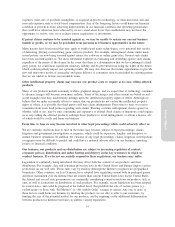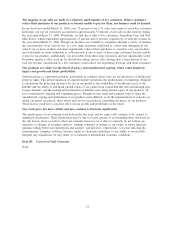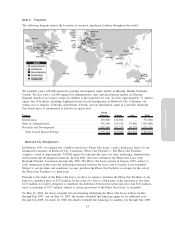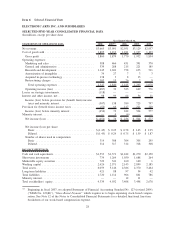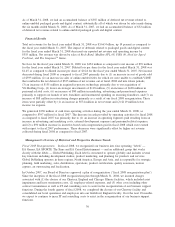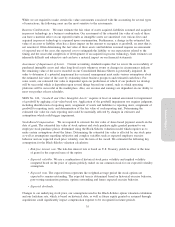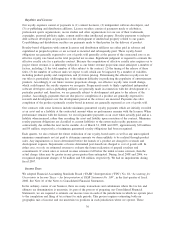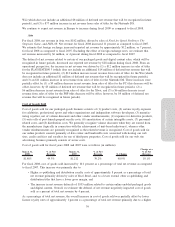Electronic Arts 2008 Annual Report Download - page 105
Download and view the complete annual report
Please find page 105 of the 2008 Electronic Arts annual report below. You can navigate through the pages in the report by either clicking on the pages listed below, or by using the keyword search tool below to find specific information within the annual report.
Item 7: Management’s Discussion and Analysis of Financial Condition and Results of Operations
OVERVIEW
The following overview is a top-level discussion of our operating results as well as some of the trends and
drivers that affect our business. Management believes that an understanding of these trends and drivers is
important in order to understand our results for the fiscal year ended March 31, 2008, as well as our future
prospects. This summary is not intended to be exhaustive, nor is it intended to be a substitute for the detailed
discussion and analysis provided elsewhere in this Form 10-K, including in the “Business” section and the
“Risk Factors” above, the remainder of “Management’s Discussion and Analysis of Financial Condition and
Results of Operations”, or the Consolidated Financial Statements and related notes.
About Electronic Arts
We develop, market, publish and distribute video game software and content that can be played by consumers
on a variety of platforms, including video game consoles (such as the Sony PlayStation»2 and PLAY-
STATION»3, Microsoft Xbox 360
TM
and Nintendo Wii
TM
), personal computers, handheld game players (such
as the PlayStation»Portable (“PSP
TM
”) and the Nintendo DS
TM
) and cellular handsets. Some of our games are
based on content that we license from others (e.g., Madden NFL Football, Harry Potter and FIFA Soccer), and
some of our games are based on our own wholly-owned intellectual property (e.g., The Sims
TM
, Need for
Speed
TM
and POGO
TM
). Our goal is to publish titles with global mass-market appeal, which often means
translating and localizing them for sale in non-English speaking countries. In addition, we also attempt to
create software game “franchises” that allow us to publish new titles on a recurring basis that are based on the
same property. Examples of this franchise approach are the annual iterations of our sports-based products (e.g.,
Madden NFL Football, NCAA»Football and FIFA Soccer), wholly-owned properties that can be successfully
sequeled (e.g., The Sims, Need for Speed and Battlefield) and titles based on long-lived literary and/or movie
properties (e.g., Lord of the Rings and Harry Potter).
Special Note Regarding Deferred Net Revenue
The ubiquity of high-speed Internet access and the integration of network connectivity into new generation
game consoles are expected to continue to increase demand for games with online-enabled features. To address
this demand, many of our software products are developed with the ability to be connected to, and played via,
the Internet. In order for consumers to participate in online communities and play against one another via the
Internet, we (either directly or through outsourced arrangements with third parties) maintain servers which
support an online service we offer to consumers for activities such as matchmaking. In situations where we do
not separately sell this online service, we account for the sale of the software product as a “bundle” sale, or
multiple element arrangement, in which we sell both the software product and the online service for one
combined price.
Through fiscal 2007, for accounting purposes, vendor-specific objective evidence of fair value (“VSOE”)
existed for the online service. Accordingly, we allocated the revenue collected from the sale of the software
product between the online service offered and the software product and recognized the amounts allocated to
each element separately. However, starting in fiscal 2008, for accounting purposes, the required vendor-specific
objective evidence of fair value did not exist for the online service related to certain of our online-enabled
software products. This prevented us from allocating and separately recognizing revenue related to the
software product and the online service. Accordingly, starting in fiscal 2008, we began to recognize all of the
revenue from the sale of our online-enabled software products for the PC, PlayStation 2, PLAYSTATION 3,
Wii and the PSP on a deferred basis over an estimated online service period, which we estimate to be six
months beginning in the month after shipment. On a quarterly basis, the deferral amount will vary significantly
depending upon the number of titles we release, the timing of their release, sales volume, returns and price
protection provided for these online-enabled software products. In addition, we expense the cost of goods sold
related to these transactions during the period in which the product is delivered (rather than on a deferred
basis), which inherently creates volatility in our reported gross margin percentages.
Annual Report
29


